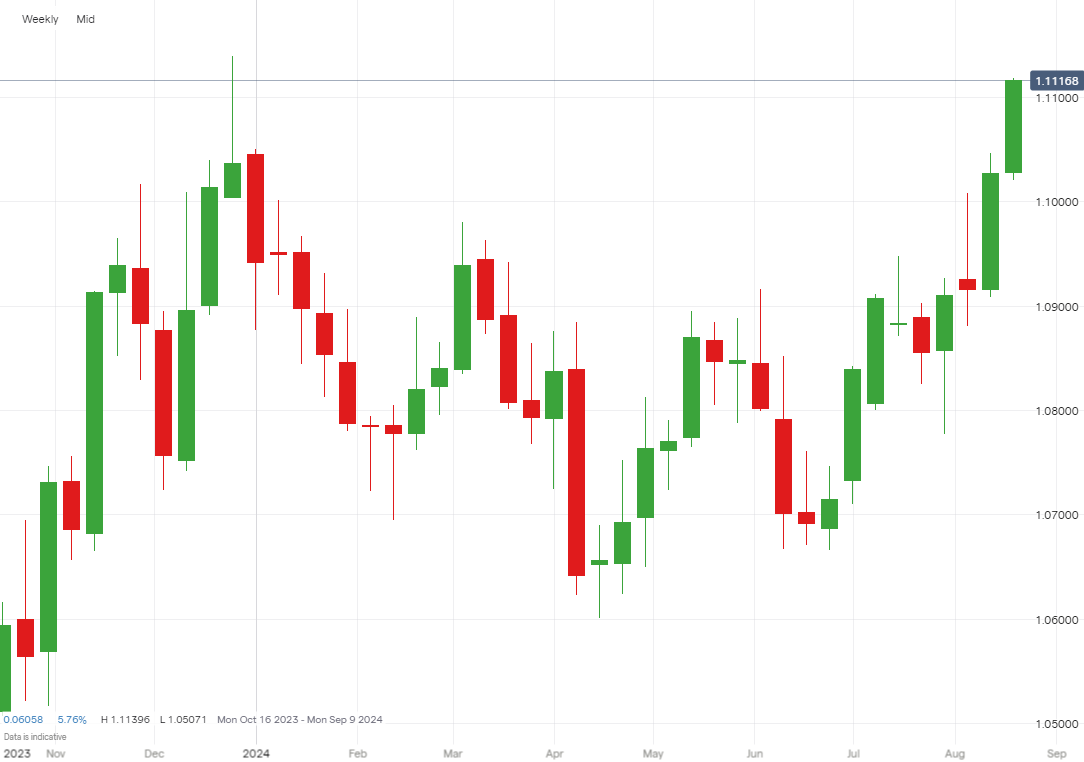EUR/USD breaks through 1.1100 as the dollar declines on rate cut expectations
EUR/USD reached 1.1100, the highest since December 2023, on US rate cut expectations. The US dollar weakened against major currencies, while traders await Powell's Jackson Hole speech and upcoming European PMI data.

Key points
- EUR/USD hit 1.1100 early Tuesday morning, the highest level since December 2023
- The US dollar has been consistently declining in August, hitting multiple down days against major currencies like GBP, AUD, CAD, and CHF
- Fed Chair Powell's upcoming speech at the Jackson Hole Symposium may confirm September rate cuts, influenced by recent economic data
- European PMI data on Thursday could impact EUR/USD, which has seen significant highs of 1.125 and lows around 1.05 in the past year
EUR/USD hits year-to-date high above 1.1100
EUR/USD reached 1.1100 at the US market open today, marking the first time at that price level since December 2023. The euro is up over 2.5% against the US dollar month-to-date as rate cut expectations accelerate in the US. Traders are now monitoring the pair for potential shifts as the market reacts to evolving economic conditions.
EUR/USD weekly price history

US dollar continues to fall against major currencies throughout August
The US dollar has been consistently declining against major currencies such as GBP, AUD, CAD, and CHF throughout August. Despite the alleviation of recent recession fears in early August, USD has now printed multiple down days in a row. Notable movements include AUD/USD reaching a month-long high above 0.6700, GBP/USD hitting a year-to-date high above 1.3050, and USD/CAD dropping to a month-long low under 1.3650.
Fed Chair Powell could confirm September rate cuts this week
Fed Chair Jerome Powell is slated to headline this week's Jackson Hole Symposium with an address that could clarify the Fed's stance on rate cuts. Since his last speech, there have been several significant data points, including a worse-than-expected unemployment rate, in-line inflation measures, and resilient retail sales. These factors have considerably influenced market sentiment throughout August, and Powell's comments could further shape expectations for upcoming monetary policy. Fed Fund futures are now pricing in a 25-bps cut in September and a full 100 bps by the December meeting. With only three meetings remaining this year, that outcome would require a 50bps cut at one of the next three meetings.
Where next for EUR/USD?
The 1.1100 level has been a significant monthly high for EUR/USD dating back to March 2022, though the pair did briefly trade as high as 1.125 in 2023. It has also seen lows around 1.05 in that timeframe. European PMI data, set to be released Thursday morning, could impact prices in the short term—if PMI figures turn contractionary, EUR/USD could fall from its current highs.
How to trade EUR/USD
- Open an account to get started, or practice on a demo account
- Choose your forex trading platform
- Open, monitor, and close positions on EUR/USD
Trading forex requires an account with a forex provider like tastyfx. Many traders also watch major forex pairs like EUR/USD and USD/JPY for potential opportunities based on economic events such as inflation releases or interest rate decisions. Economic events can produce more volatility for forex pairs, which can mean greater potential profits and losses as risks can increase at these times.
You can help develop your forex trading strategies using resources like tastyfx’s YouTube channel. Our curated playlists can help you stay up to date on current markets and understanding key terms. Once your strategy is developed, you can follow the above steps to opening an account and getting started trading forex.
Your profit or loss is calculated according to your full position size. Leverage will magnify both your profits and losses. It’s important to manage your risks carefully as losses can exceed your deposit. Ensure you understand the risks and benefits associated with trading leveraged products before you start trading with them. Trade using money you’re comfortable losing.
